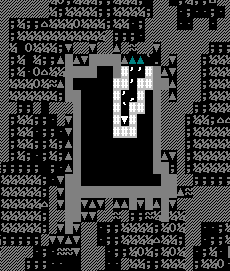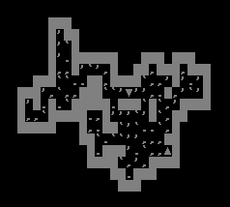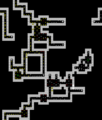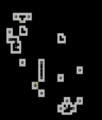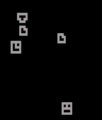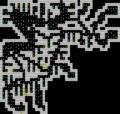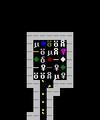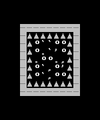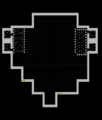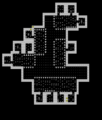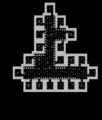- v50 information can now be added to pages in the main namespace. v0.47 information can still be found in the DF2014 namespace. See here for more details on the new versioning policy.
- Use this page to report any issues related to the migration.
Cave
v50.12 · v0.47.05 This article is about the current version of DF.Note that some content may still need to be updated. |
- Not to be confused with Caverns.
A cave is a small, natural site. It features a large rock mound several z-levels high with a downward passage beginning anywhere along the side of the mound. The passage most often leads deep down into a cavern. Rarely, a cave may lack any passage or even an entrance into the mound.
Most caves have a natural population of subterranean animals, such as cave swallows and bats. Certain megabeasts, semi-megabeasts and night creatures will settle in caves. If a cave is inhabited by creatures fond of stealing items from nearby sites, their hoard will be littered all over the site. Dragons are known to hoard jewelry; ettins and giants hoard jewelry, food, and alcohol.
Civilized races can also settle in an unoccupied cave. Caves are the starting site of kobolds. Kobold caves have an extended underground network of tunnels and chambers that are connected to the natural passageway. Like other sites, caves can be attacked by invaders or monsters. They are one of the few known sites that players can embark on without third-party tools.
Generation
The site encompasses 3×3 embark tiles, although the cave mound itself only takes up one embark tile, or 48×48 tiles. The mound can be located in any of the embark tiles, so it is not always found at the center of the site.
There are two ways caves can generate: mountain caves occur adjacent to a mountain region tile, while non-mountain caves occur in any land biome other than mountains. The number of caves per world is determined by the parameters Number of Mountain Caves and Number of Non-Mountain Caves. Both parameters can be configured in advanced world generation.
Caves are displayed on the world map as •. Caves are hidden on the map by the default world settings, so they are not visible until they are discovered by adventurers. In advanced world gen, setting the option Make Caves Visible to Yes will make caves visible from the start.
Inside the cave, there are two ramps on each z-level, one going up and one going down. The ramps make a path that goes from the surface to the underground. The pathway is not always a straight line; on some z-levels, the passage can spread out into a small gallery.
The distribution of items (including artifacts) are scattered within the site borders, from the surface to any subterranean levels reachable by foot, i.e., no loot will be found beyond a rampless drop or a submerged passage, even if the hoard's owner is a flying or amphibious creature.
Kobold cave
A cave inhabited by skulking thieves have an additional complex network of subterranean passages that link from a single entryway to the natural passage of the cave mound. The underground network is located close to the surface and above the caverns; sometimes it is located just one z-level below the ground. Kobolds, poisonous critters, and stolen treasure can be found here.
It is easy to get lost in the network of tunnels which are one tile wide and wind in every direction. Certain sections use both ramps and stairs to go up and down several z-levels. Along the path are occasional 3×3 guard posts with armed kobolds. Hidden weapon traps are very frequent and pose danger. Certain segments and corners are holed with tiny pits which have even more traps at the bottom. A unique feature of this site is that each weapon trap is coated with a syndrome-inducing venom that ranges from bumblebee venom to rattlesnake venom to the dangerously lethal venom of the giant cave spider. If a trap hits successfully, the coated weapon will inject the venom into the intruder. Since fast travel or rest is generally not possible in a cave, you will most likely be forced to endure (or succumb) to the venom's effects.
The network of passageways connect the five main rooms: a trophy room, a large pit room for tamed animals, a room for eggs, a room filled with corpses, and the living chambers. Stolen artifacts are piled with other stolen items in the trophy room. The living chambers are irregular cavities that contain many hostile kobolds. The pit room for animals is the largest room, spanning several z-levels deep in gradual slopes, poked with 3×3 enclosures on the sides. This room can include any poisonous non-mammal creatures.
According to legends, kobolds may construct a market in their cave. As there is no evidence of any structure resembling a market in kobold caves, they are probably either an error or serve an unknown purpose during world generation.
Dwarf fortress mode
In dwarf fortress mode, you can choose whether or not to make caves visible on the embark screen when you design the world you will play in. The default option for Make Caves Visible is set to No. If set to yes, caves will appear on the map so that they may be sought out or avoided as desired. Caves have the odd feature that the stone they are made of doesn't match the material left after it is dug out; for example, a rock wall will leave behind a clay floor.
Adventurer mode
Caves can sometimes be found by repeatedly asking an NPC about the surroundings. They are the only way of entering the underground in adventurer mode besides visiting a dwarven fortress which has an entrance to a cavern; if NPCs in one region don't tell you about any caves, move to another region and try again.
"Cave" in other Languages
|
Worlds | |||||||||
|---|---|---|---|---|---|---|---|---|---|
| General | |||||||||
| Map |
| ||||||||
| Civilization |
| ||||||||
